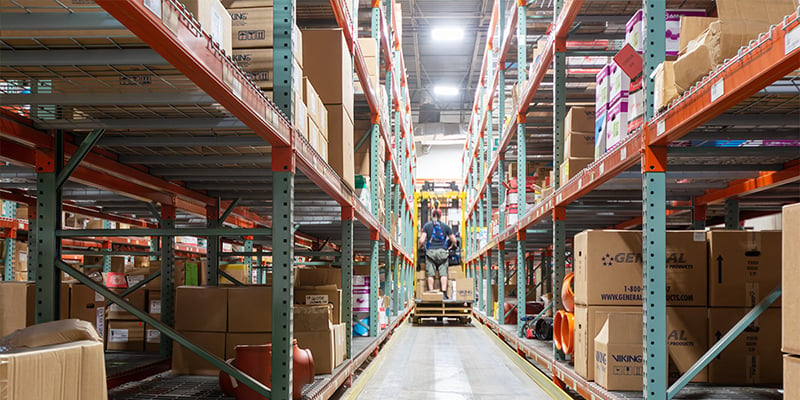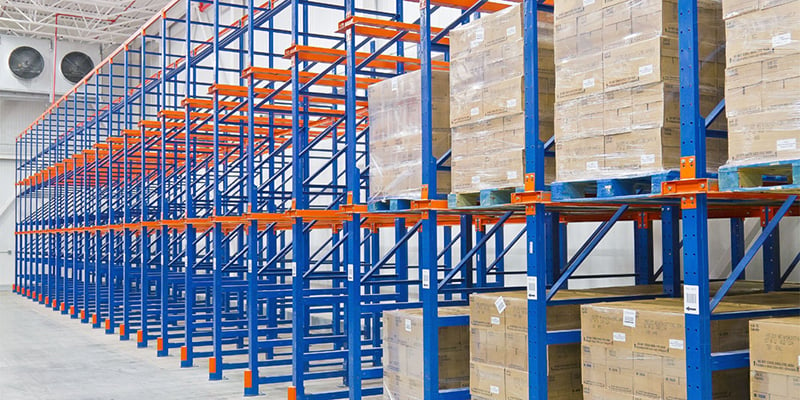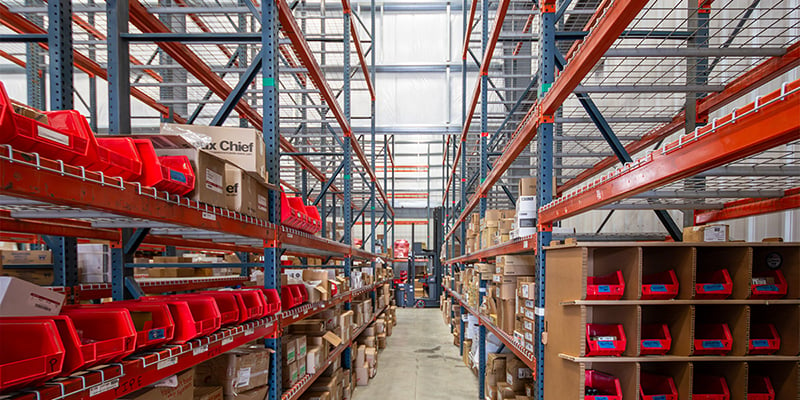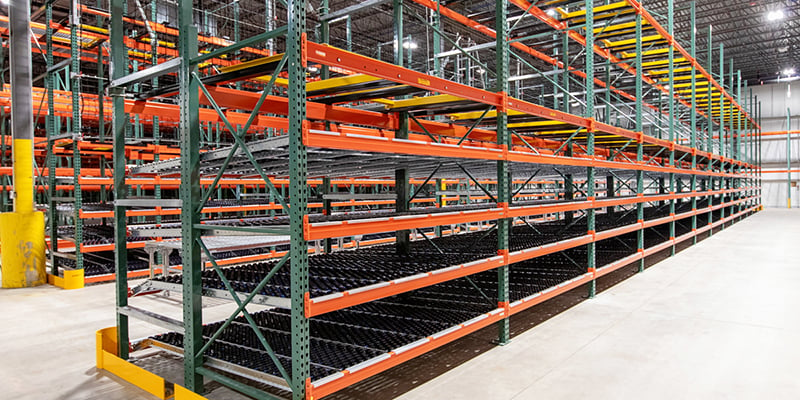The American third-party logistics (3PL) market is projected to grow more than 8% annually between 2025 and 2029, according to Technavio. That's an impressive $132 billion in growth, but earning a share of it means running smarter. And for most warehouses, running smarter starts with how efficiently you use your space.
One of the most overlooked, but most foundational decisions in that process: Choosing the right pallet racking system.
Warehouses across the country are feeling the squeeze. In Exteniv's annual State of the Ecommerce Fulfillment Industry report, nearly 60% of warehouses are operating at 90% capacity or higher. When that's the baseline, even small improvements in layout, access, and rack durability can lead to major gains in throughput and safety.
Too often, racking gets treated like a commodity, like it's just steel and space. But matching the right system to your environment can help prevent damaged inventory, reduce maintenance costs, and protect your team.
Roll-form and structural racking may look similar at first glance, but how they're built, and where they perform best, are very different stories. This guide breaks down the tradeoffs and gives you a clear-eyed comparison so you can make the right call for your operation.
What's the Difference? Roll-Form vs. Structural Racking
When comparing roll-form and structural racking, it helps to start with how each system is built and how its construction affects performance in real warehouse environments.
Roll-form racking is made from cold-rolled steel shaped into standardized, lightweight components. It's not designed for the same impact resistance or heavy-duty capacity as structural racking, but that tradeoff comes with benefits.

Roll-form racks are easier to install, adjust, and reconfigure. Most uprights have punched face holes, allowing beams to clip in without bolts. They're fast to assemble, and even faster to readjust. That's why roll-form systems are a common choice in facilities where SKU profiles shift regularly, loads are light to moderate, and flexibility is key.
Structural racking, by contrast, uses hot-rolled, low-gauge channel steel that's bolted together. It takes longer to install and reconfigure, but delivers more durability under stress.

These racks hold up under constant forklift traffic, heavy pallets, and high-abuse environments where damage is more than a possibility. Structural racking is often the go-to for cold storage, drive-in systems, and warehouses where uptime and safety depend on long-term track resilience.
Key Comparison Categories
Construction and connection are just the starting points. Choosing the wrong rack type for your environment can lead to faster wear and tear, product damage, and even safety risks for your team.
To help you make the right call, we’re breaking down five key performance factors that separate roll-form racking and structural racking, and how each one impacts cost, durability, and day-to-day operations.
Load Capacity
If your operation involves heavy pallets, structural racking offers a clear advantage. On average, structural systems provide 20-30% more load capacity than comparable roll-form racks — making them better suited for dense, high-weight storage.
That added strength means you can store more product in the same footprint, which is critical in space-constrained warehouses handling heavy goods like bulk packaging, beverages, or industrial materials.

Structural racks also hold up longer under heavier strains. Their thicker, hot-rolled steel resists deflection over time, helping prevent sagging beams, damaged uprights, and dangerous failures. By contrast, pushing a roll-form rack beyond its limits can lead to bent components and, in worst cases, full rack collapse.
Impact Resistance & Abuse Tolerance
A warehouse isn't a china shop. Impacts happen. In high-traffic operations, forklift collisions are part of the job, especially with new operators or tight aisles.

Structural systems use hot-rolled, low-gauge steel that resists corrosion and handles thermal stress far better than thinner, roll-form profiles. That makes them ideal for refrigerated storage, food and beverage processing, outdoor yards, and washdown environments where racks must be sanitized regularly and stand up to temperature extremes.
Installation & Adjustability
The layout you install today won't always match the workflow you'll need tomorrow, and that's where roll-form racking really shines.
Lightweight and modular, roll-form systems are designed for easy reconfiguration. Beams snap into pre-punched uprights, so shelf heights and layouts can be adjusted without tools or downtime. That flexibility makes them ideal for fast-moving environments with a wide variety of SKUs or frequent inventory shifts.

Structural racking, by contrast, is more “set it and forget it.” Because beams are bolted to uprights, reconfiguring requires unloading, unbolting, and often professional support, which are all better suited for static zones with consistent product sizes and predictable demand.
Upfront Cost vs. Long-Term ROI
Roll-form racking is the cheaper install — no surprise there. It’s lighter to ship, faster to assemble, and rarely requires custom fabrication. For budget-conscious projects or low-abuse environments, that upfront savings can make a lot of sense.

But those savings disappear quickly if your racks take a beating. Bent beams, damaged uprights, and frequent replacements can turn roll-form racks into a recurring expense, especially in high-traffic zones where impacts are routine.
Structural racking, on the other hand, costs more up front but delivers when it counts. Built from heavier steel and bolted together for maximum durability, it’s designed to outlast and outperform in high-impact environments. Where roll-form might last 5-7 years, structural systems can easily hit 15-20 + years, even in freezers, drive-in systems, and around forklifts.
Explore Your Racking Options
Now that you've got a better understanding of structural vs. roll-form racking, here's a quick guide to our available racking systems, grouped by rack type, so you can find the right fit for your warehouse setup.
Structural Racking Systems
These systems are designed for long-term durability, high-capacity loads, and environments that demand resilience.
- Frazier Sentinel Structural Racking: Engineered for strength and impact resistance in demanding environments like freezer storage, drive-in systems, and heavy-duty staging areas.
- Frazier Drive-In/Drive-Thru Racks: Ideal for high-density storage with limited-access aisles, supporting deep-lane storage and maximizing cube utilization.
- Frazier Glide-In Push-Back Racking: Combines deep-lane efficiency with last-in, first-out (LIFO) inventory management. Perfect for high-turnover items.
- Frazier Pallet Mole®: Supports ultra-dense storage while automating pallet movement in deep-lane setups.
- Ban-Air IARS (Instantly Adjustable Racking System): Structural frame with modular shelves, drawers, and pallet platforms. Durable and adaptable.
- Carton Flow Racking (with Structural Frames): Uses gravity-fed rollers in a structural frame to support high-efficiency, high-throughput picking applications.
- Roll-Out Pallet Racks (Structural-Mounted): Add ergonomic access and space-saving pull-out functionality to structural bays.
Roll-Form Racking Options
Lightweight, flexible, and budget-friendly. These racks excel in dynamic warehouse zones with frequent reconfiguration.
- Carton Flow Racking (with Roll-Form Frame): Great for order picking and small goods, these systems pair well with flexible warehouse layouts.
- Roll-Out Pallet Racks (Roll-Form Mounted): Mounts directly to roll-form uprights for space optimization and safer material access.
- Unex FlowCell: A modular gravity-flow system that improves ergonomics and inventory access in assembly and kitting areas.
Notes: Some systems, like Roll-Out Racks, can be built on either structural or roll-form frames depending on application requirements. Not sure which configuration is right for you? We can help.
Choosing the Right System for Your Warehouse
There’s no universally perfect rack. Only the one that fits your workflow, your product profile, and your warehouse environment. That’s why the best racking decisions start with how you move product today…and how that might evolve tomorrow.
Structural racking brings the durability you need for harsh conditions, heavy pallets, and high-impact zones. Roll-form systems offer modularity and affordability wherever flexibility matters more than brute strength.

In many cases, the best approach is a mix of both — using structural and roll-form racking throughout your warehouse according to the zone and need. Or you could choose a hybrid system which combines lightweight modularity with just the right amount of rugged steel to support ergonomic, gravity-fed picking.
At the end of the day, it all comes down to how your warehouse works and where it plans to grow. Whatever your setup looks like, Patterson Pope can help custom-design a racking system that matches how your team works and how your business grows. We’ll help you choose the right racking for today’s workload and tomorrow’s opportunities.

















